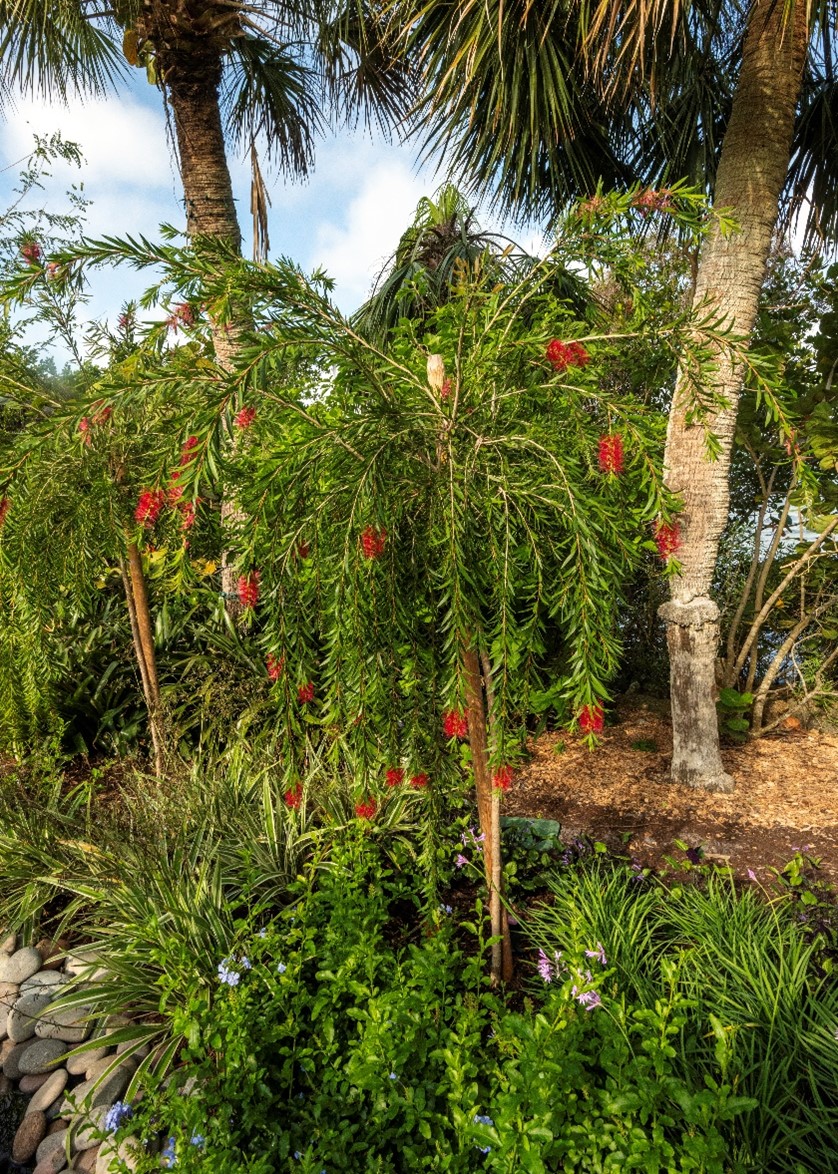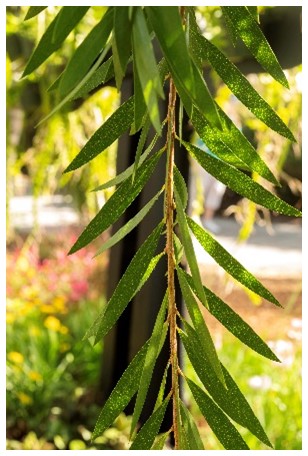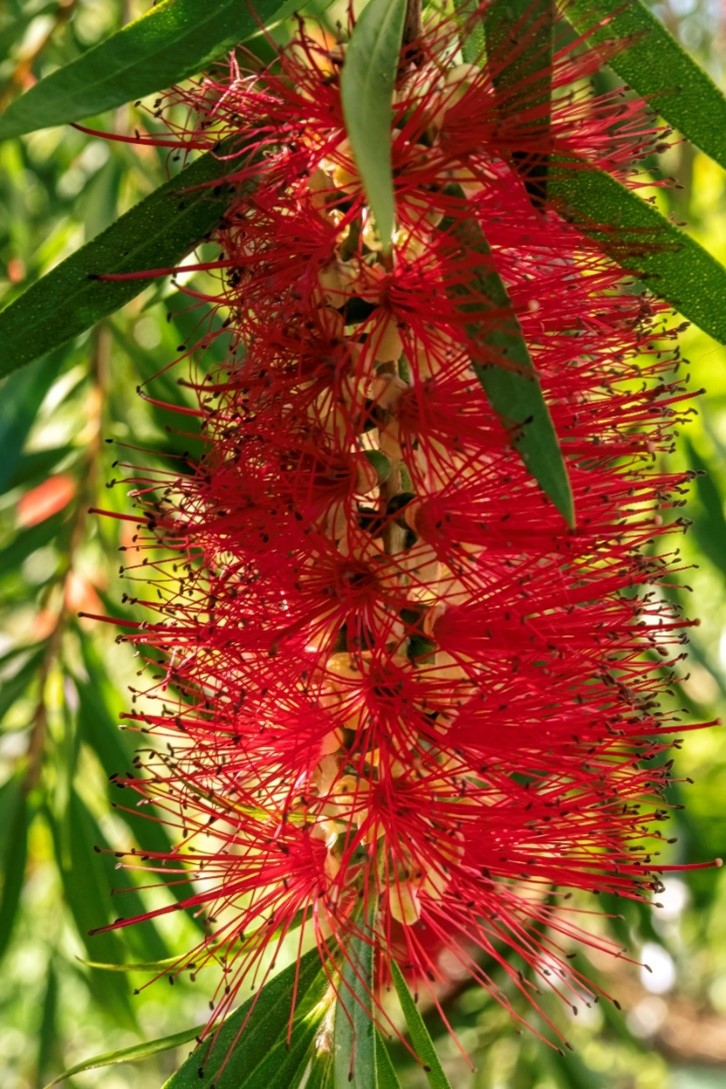
Young bottlebrush tree in bayfront exhibit. Inset: Weeping stem and leaves of bottlebrush (Photos by Aaron Fink)

Written by Shawn McCourt, Ph.D., Plants Record Keeper
Claude Monet’s famous paintings of his gardens and home at Giverny in France have been brought to life in new and fanciful forms, thanks to the inspired reimagining of pop artist Roy Lichtenstein. For Roy Lichtenstein: Monet’s Garden Goes Pop *, Selby Gardens’ horticulture staff were tasked with assembling on its 15-acre Downtown Sarasota campus many of the physical elements of Giverny as seen through the eyes of Lichtenstein. To bring rural Giverny to sunny, coastal Sarasota, staff needed to use the types of plants that evoke the essence of Giverny in the public mind: especially its waterlilies (Nymphaea spp.) and weeping willow trees (Salix babylonica). While waterlilies grow in Florida’s subtropical climate, weeping willows unfortunately do not. A tropical or subtropical look-alike had to be found as a stand-in, and the weeping bottlebrush, Melaleuca viminalis (formerly Callistemon viminalis) was considered the best fit. With its narrow leaves, furrowed bark, and weeping habit, M. viminalis bears a remarkable resemblance to Salix babylonica, especially when not in bloom. Like weeping willow trees, it also prefers to grow along streams on the coastal plains of its native range from Cape York to New South Wales in eastern Australia. One characteristic it does not share with willow trees are bright red flower clusters resembling the wire brushes traditionally used to scrub the insides of glass bottles – hence, the common name of “bottlebrush”. Despite the plant’s exotic origin, these flowers are much loved by native Florida pollinators like bees and hummingbirds. In various shades from white to pink, yellow, or red, the bristly clusters of staminate flowers are characteristic of the nearly 300 or so Melaleuca species found in the myrtle family, the Myrtaceae. The clusters of flowers, which botanists call “spikes”, are comprised of many individual flowers with much-reduced petals and calyces, and with their anthers containing pollen borne on long, slender filaments, or stamens, that make up much of the “bottlebrush”. After pollination, the flowers are followed by clusters of hard, woody capsules which may hang on the branches for many years before releasing the tiny seeds. The term for this slow release of seed is serotiny, and many serotinous species also require fire to release the seeds from the capsules. Fire-mediated serotiny is an ecological adaptation to areas subject to frequent wildfires, and it can be found across many different plant taxa, but especially in eucalypts, proteas and conifers. In addition to having serotinous woody capsules, fire-adapted plants like Melaleuca generally also contain volatile oils and terpenes that are highly flammable and give the plants their characteristic citrus or menthol odors. The oils help the plants to mediate the effects of wildfires, since they encourage more frequent, swift-moving, low intensity burns instead of the hot, killing fires that would result from the buildup of organic matter over time. These essential oils also often have antimicrobial and antibiotic properties and have been used by traditional communities for centuries. One example is Melaleuca alternifolia, a small tree endemic to Queensland, which is grown commercially for the fragrant “tea tree oil” extracted for use as a topical antiseptic, antifungal, and sanitizer. Most melaleucas are endemic to mainland Australia, with just a few scattered across Tasmania, Lord Howe Island, Indonesia, New Caledonia and New Guinea; and with one subspecies, Melaleuca cajuputi subsp. cumingiana, extending northwards into Myanmar, Thailand, and Vietnam.
A small number of larger Melaleuca species from northern Australia are valued as timber due to their resistance to rot and termites, but many others are popular ornamentals. Several species have become naturalized when planted in other parts of the world, with some becoming serious pests costing public and private businesses hundreds of millions of dollars each year in eradication programs. Since its introduction to Florida in 1906 as a potential commercial timber crop, the broadleaved paperbark tree (Melaleuca quinquenervia) has invaded thousands of miles of natural habitat, displacing native vegetation and impoverishing critical habitat for wildlife. Despite efforts to control its spread, the Florida Fish and Wildlife Commission estimates that paperbark trees currently inhabit more than 400,000 acres, mostly in South Florida. It displaces natural pine flatwoods, cypress swamps, and sawgrass communities, disrupts ecosystems and freshwater flow and increases fire risk in areas not usually prone to frequent fires. This is due to highly combustible volatile oils in the stems, bark and leaves. The Global Invasive Species Database now lists Melaleuca quinquenervia as one of the 100 worst invasive species in the world. Thankfully, the weeping bottlebrush (Melaleuca viminalis) does not appear to be able to naturalize in Florida, making it a delightful “Florida-friendly” choice for gardens and landscapes seeking to recall the serenity and beauty of willow-draped places like Monet’s Giverny.
*The 2021 Jean & Alfred Goldstein Exhibition Series: Roy Lichtenstein: Monet’s Garden Goes Pop runs until June 27th at Selby Gardens’ Downtown Sarasota campus.

Prominent stamens and styles (both red in M. viminalis) and much reduced petals and sepals are characteristic of all Melaleucas (photo by Aaron Fink).
Additional Resources:
Craven, Lyndley (2006). New combinations in Melaleuca for Australian species of Callistemon (Myrtaceae). Novon. 16 (4): 468–475.
